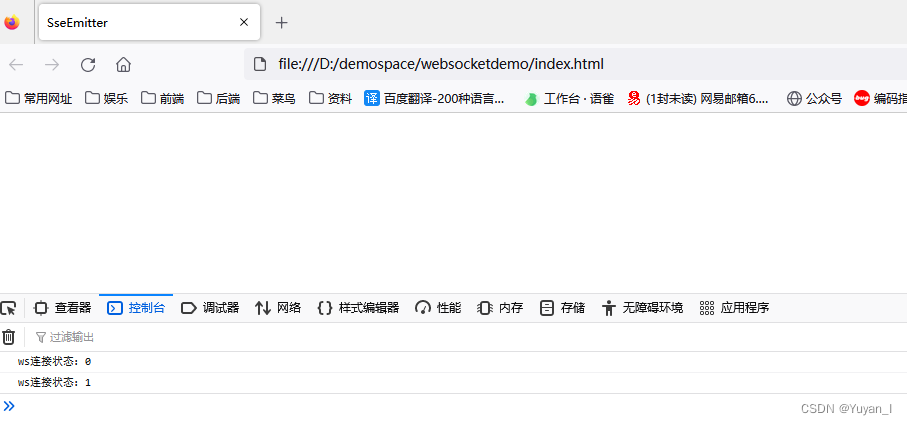WebSocket–入门
公司领导提出了一个新的需求,那就是部门主管在有审批消息的情况下,需要看到提示消息。其实这种需求最简单的方法使接入短信、邮件、公众号平台。直接推送消息。但是,由于使自研项目,公司领导不想花钱,只能另辟蹊径。
WebSocket简介
WebSocket协议是基于TCP的一种新的网络协议。它实现了浏览器与服务器全双工(full-duplex)通信,即允许服务器主动发送信息给客户端。因此,在WebSocket中,浏览器和服务器只需要完成一次握手,两者之间就直接可以创建持久性的连接,并进行双向数据传输,客户端和服务器之间的数据交换变得更加简单。
WebSocket-实现后端推送消息给前端
依赖导入
<!-- 该依赖包含 SpringBoot starer 无需重复导入 -->
<dependency>
<groupId>org.springframework.boot</groupId>
<artifactId>spring-boot-starter-websocket</artifactId>
<version>2.7.0</version>
</dependency>
<!-- 除此之外我们还需要lombok 和 fastjson -->
<!-- 这里就不导入了 -->
代码实现
WebSocketConfig
import org.springframework.context.annotation.Bean;
import org.springframework.context.annotation.Configuration;
import org.springframework.web.socket.server.standard.ServerEndpointExporter;
@Configuration
public class WebSocketConfig {
@Bean
public ServerEndpointExporter serverEndpointExporter() {
return new ServerEndpointExporter();
}
}
WebSocketMessage–封装的消息结果类(非必须)
import lombok.Data;
@Data
public class NoticeWebsocketResp<T> {
private String noticeType;
private T noticeInfo;
}
WebSocketServer
import com.alibaba.fastjson.JSONObject;
import com.mydemo.websocketdemo.domain.NoticeWebsocketResp;
import lombok.extern.slf4j.Slf4j;
import org.springframework.stereotype.Component;
import org.springframework.util.StringUtils;
import javax.websocket.*;
import javax.websocket.server.PathParam;
import javax.websocket.server.ServerEndpoint;
import java.io.IOException;
import java.util.*;
import java.util.concurrent.ConcurrentHashMap;
@ServerEndpoint("/notice/{userId}")
@Component
@Slf4j
public class NoticeWebsocket {
//记录连接的客户端
public static Map<String, Session> clients = new ConcurrentHashMap<>();
/**
* userId关联sid(解决同一用户id,在多个web端连接的问题)
*/
public static Map<String, Set<String>> conns = new ConcurrentHashMap<>();
private String sid = null;
private String userId;
/**
* 连接成功后调用的方法
* @param session
* @param userId
*/
@OnOpen
public void onOpen(Session session, @PathParam("userId") String userId) {
this.sid = UUID.randomUUID().toString();
this.userId = userId;
clients.put(this.sid, session);
Set<String> clientSet = conns.get(userId);
if (clientSet==null){
clientSet = new HashSet<>();
conns.put(userId,clientSet);
}
clientSet.add(this.sid);
log.info(this.sid + "连接开启!");
}
/**
* 连接关闭调用的方法
*/
@OnClose
public void onClose() {
log.info(this.sid + "连接断开!");
clients.remove(this.sid);
}
/**
* 判断是否连接的方法
* @return
*/
public static boolean isServerClose() {
if (NoticeWebsocket.clients.values().size() == 0) {
log.info("已断开");
return true;
}else {
log.info("已连接");
return false;
}
}
/**
* 发送给所有用户
* @param noticeType
*/
public static void sendMessage(String noticeType){
NoticeWebsocketResp noticeWebsocketResp = new NoticeWebsocketResp();
noticeWebsocketResp.setNoticeType(noticeType);
sendMessage(noticeWebsocketResp);
}
/**
* 发送给所有用户
* @param noticeWebsocketResp
*/
public static void sendMessage(NoticeWebsocketResp noticeWebsocketResp){
String message = JSONObject.toJSONString(noticeWebsocketResp);
for (Session session1 : NoticeWebsocket.clients.values()) {
try {
session1.getBasicRemote().sendText(message);
} catch (IOException e) {
e.printStackTrace();
}
}
}
/**
* 根据用户id发送给某一个用户
* **/
public static void sendMessageByUserId(String userId, NoticeWebsocketResp noticeWebsocketResp) {
if (!StringUtils.isEmpty(userId)) {
String message = JSONObject.toJSONString(noticeWebsocketResp);
Set<String> clientSet = conns.get(userId);
if (clientSet != null) {
Iterator<String> iterator = clientSet.iterator();
while (iterator.hasNext()) {
String sid = iterator.next();
Session session = clients.get(sid);
if (session != null) {
try {
session.getBasicRemote().sendText(message);
} catch (IOException e) {
e.printStackTrace();
}
}
}
}
}
}
/**
* 收到客户端消息后调用的方法
* @param message
* @param session
*/
@OnMessage
public void onMessage(String message, Session session) {
log.info("收到来自窗口"+this.userId+"的信息:"+message);
}
/**
* 发生错误时的回调函数
* @param error
*/
@OnError
public void onError(Throwable error) {
error.printStackTrace();
}
}
这样我们就配置好了websocket
测试准备
访问接口–当请求该接口时,主动推送消息
import com.mydemo.websocketdemo.domain.NoticeWebsocketResp;
import com.mydemo.websocketdemo.websocketserver.NoticeWebsocket;
import org.springframework.web.bind.annotation.GetMapping;
import org.springframework.web.bind.annotation.RequestMapping;
import org.springframework.web.bind.annotation.RestController;
@RestController
@RequestMapping("/order")
public class OrderController {
@GetMapping("/test")
public String test() {
NoticeWebsocket.sendMessage("你好,WebSocket");
return "ok";
}
@GetMapping("/test1")
public String test1() {
NoticeWebsocketResp noticeWebsocketResp = new NoticeWebsocketResp();
noticeWebsocketResp.setNoticeInfo("米奇妙妙屋");
NoticeWebsocket.sendMessageByUserId("1", noticeWebsocketResp);
return "ok";
}
}
springboot启动类
import org.springframework.boot.SpringApplication;
import org.springframework.boot.autoconfigure.SpringBootApplication;
@SpringBootApplication
public class WebSocketApplication {
public static void main(String[] args) {
SpringApplication.run(WebSocketApplication.class,args);
}
}
前端测试页面
<!DOCTYPE html>
<html lang="en">
<head>
<meta charset="UTF-8">
<title>SseEmitter</title>
</head>
<body>
<div id="message"></div>
</body>
<script>
var limitConnect = 0;
init();
function init() {
// 8080未默认端口,可自行替换
var ws = new WebSocket('ws://localhost:8080/notice/2');
// 获取连接状态
console.log('ws连接状态:' + ws.readyState);
//监听是否连接成功
ws.onopen = function () {
console.log('ws连接状态:' + ws.readyState);
limitConnect = 0;
//连接成功则发送一个数据
ws.send('我们建立连接啦');
}
// 接听服务器发回的信息并处理展示
ws.onmessage = function (data) {
console.log('接收到来自服务器的消息:');
console.log(data);
//完成通信后关闭WebSocket连接
// ws.close();
}
// 监听连接关闭事件
ws.onclose = function () {
// 监听整个过程中websocket的状态
console.log('ws连接状态:' + ws.readyState);
reconnect();
}
// 监听并处理error事件
ws.onerror = function (error) {
console.log(error);
}
}
function reconnect() {
limitConnect ++;
console.log("重连第" + limitConnect + "次");
setTimeout(function(){
init();
},2000);
}
</script>
</html>
之后用浏览器打开html页面,显示如下:

连接成功
调用接口
localhost:8080/order/test

证明后端推送消息给前端成功